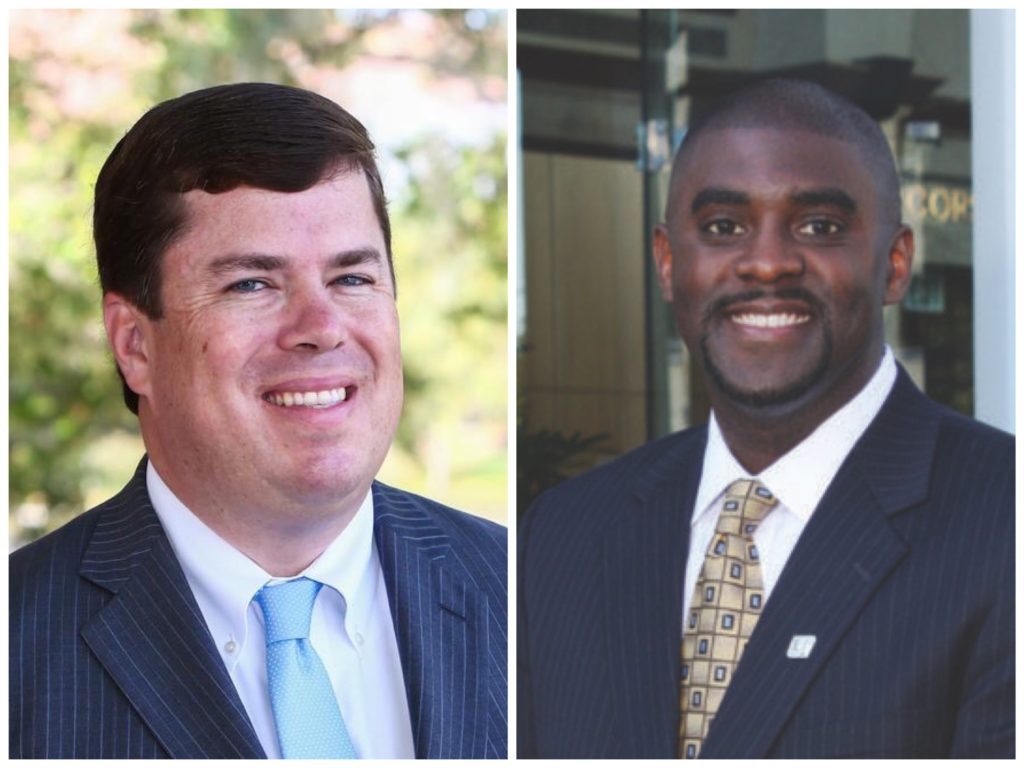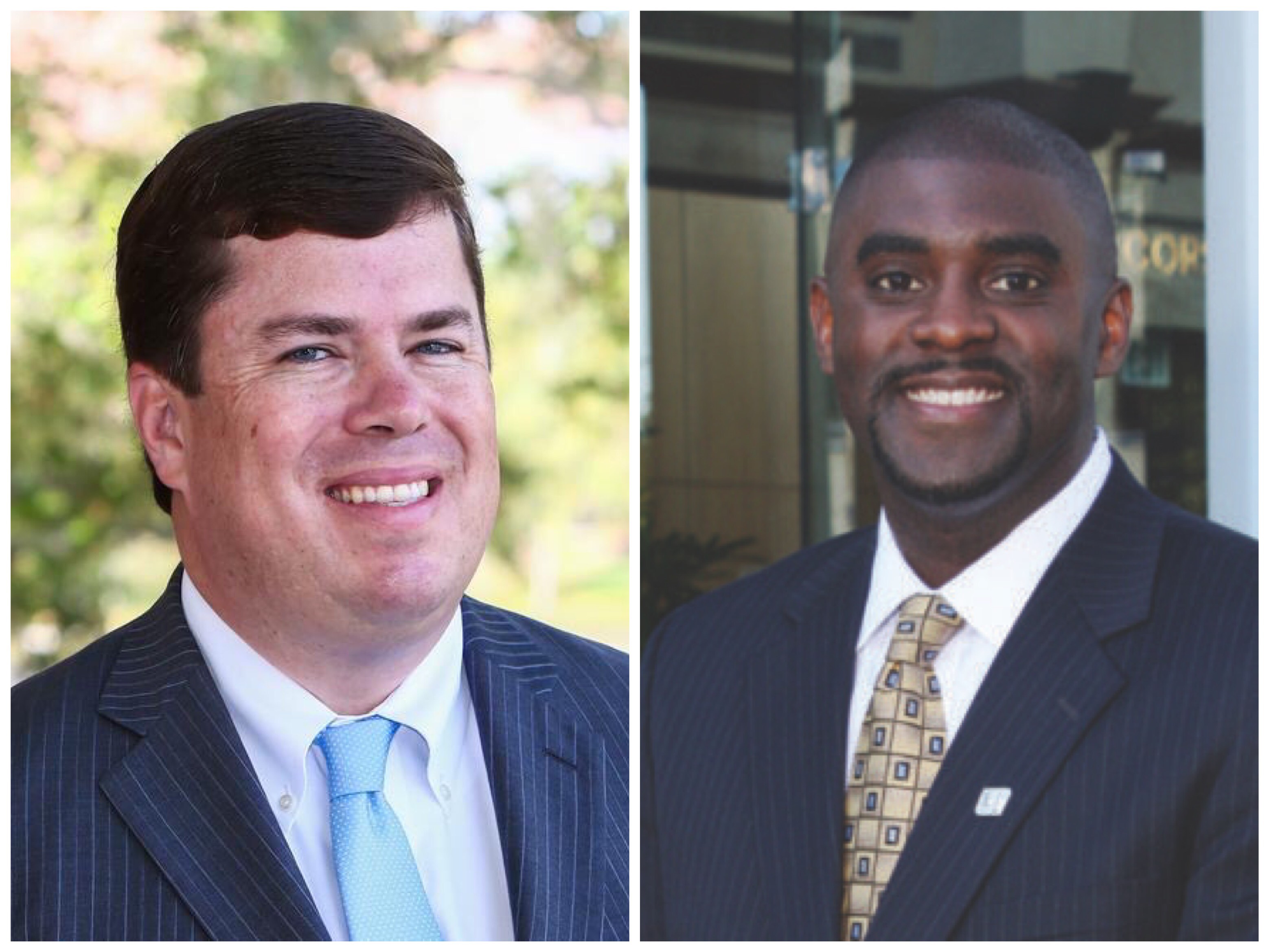
Mike Griffin (left), the chair of the Consolidation Task Force, says USF St. Petersburg should become a branch campus as defined by the criteria of the regional agency that accredits USF. But Brian Lamb, the chair of the USF Board of Trustees, and other trustees have not explained what they mean by “branch campus.” Courtesy of Mike Griffin and The Crow’s Nest archive
By Nancy McCann
The USF Board of Trustees has approved an implementation plan and timeline to consolidate the three campuses of the university system by 2020.
But what the future holds for the St. Petersburg campus is still not clear.
The 810-page plan that was unanimously approved March 5 says that the trustees and USF system President Judy Genshaft support making St. Petersburg and Sarasota-Manatee “branch campuses.”
But Genshaft has said several times that she actually favors a different description for the two campuses — somewhere “in-between” a branch campus and what is called an “instructional site.”
That could leave St. Petersburg and Sarasota-Manatee with little control over their budgets, hiring, administration and faculty.
So what do the trustees mean by “branch campus”?
During the discussion that preceded their vote, none of the trustees spelled it out.
In contrast, a task force established by the Legislature to advise the trustees on consolidation was explicit.
It recommended making St. Petersburg and Sarasota-Manatee branch campuses under the criteria of the agency that accredits USF – the Southern Association of Colleges and Schools Commission on Colleges.
That would give the two campuses their own budgetary and hiring authority and their own faculty and administrative organization.
After the trustees meeting, a Crow’s Nest reporter approached Brian Lamb, the trustees’ chair, to request a brief interview to clarify what the trustees mean by “branch campuses.”
Lamb had a one-word response: “No.”
A few minutes later, The Crow’s Nest approached him again. He said he does not comment to the press without his university spokesperson being present.
A university staff member said Lamb was rushing to catch a plane.
But two days later, in a telephone interview with The Crow’s Nest, the chair of the Consolidation Task Force – Mike Griffin – said he believes Lamb agrees with the task force’s definition of what a branch campus is.
“I can’t speak for the entire board (of trustees),” said Griffin. But “Lamb made it very clear in that meeting that he supports branch campuses, and I believe he does mean the same thing we (the task force) are saying.
“I am confident that our report is consistent with Lamb.”
By law, the trustees must submit their adopted plan to the Board of Governors of the State University System of Florida by March 15. When the trustees approved the plan, they authorized Lamb to make changes that are consistent with the guiding principles for consolidation they adopted last April.
The No. 1 priority
During the trustees meeting, Genshaft and others again made it clear that their No. 1 priority in the consolidation process is making sure that the USF system remains a “preeminent state university” – a designation that USF Tampa was awarded last summer for the first time.
(The University of Florida and Florida State are the only other state universities with the preeminence designation.)
“I really appreciate the branch campus support,” said trustee Stephanie Goforth, who is also chair of the USF St. Petersburg Campus Board. “But it goes without saying that we are not willing – I am not willing – as chair of that campus board to jeopardize preeminence in any way.
“Preeminence is it – it’s student success,” she said.
As a preeminent university, USF Tampa is entitled to extra state funds each year. This year that meant an extra $6.1 million.
To continue receiving the prestige and extra money that come with preeminence, USF must continue to meet or exceed at least 11 of the 12 metrics – or academic yardsticks – that the Legislature established when it created the preeminence designation in 2013.
Genshaft and the USF Tampa Faculty Senate have warned that St. Petersburg and Sarasota-Manatee might pull down USF’s scores on some of the metrics once consolidation takes effect.
That’s why the Tampa Faculty Senate opposes giving the two campuses much independence.
That’s also why Genshaft gave a presentation to the trustees about four-year graduation rates and retention rates, the two preeminence metrics that she said need the most attention.
The retention rate is the percentage of full-time, first-time-in-college freshmen who remain at the university the next year.
She said USF Tampa “meets or exceeds” goals set last year for the two metrics, but that wasn’t always the case.
The four-year graduation rate in Tampa went from 24.6 percent in 2000 to 60 percent today, Genshaft said, and “it’s the same story for our retention rates.”
A slide she displayed put Tampa’s retention rate at 91 percent (2017-2018).
After summoning St. Petersburg’s regional chancellor, Martin Tadlock, to join her at the podium, she had some pointed words about USF St. Petersburg’s metrics.
She displayed a slide that showed St. Petersburg’s four-year graduation rate is 32.1 percent (2014-2018) and its retention rate for first-time-in-college freshmen is 74 percent (2017-2018) – both below the preeminence benchmarks of 60 percent and 90 percent.
“You can see USF St. Petersburg and we have some work to do,” Genshaft said.
“We know this is absolutely below what we wanted to see happen,” Tadlock said. This is a “one-year snapshot” of a particular freshman group, and there was a 10 percentage point increase in the freshman retention rate the previous year, he said.
“This is very, very disappointing for all of us on the St. Petersburg campus,” said Goforth. “This is unacceptable. We will not allow this to continue.”
Raising the metrics
Later in the meeting, Tadlock summarized efforts that are underway to increase graduation and retention rates in St. Petersburg.
“We have aligned our admissions with the USF system,” Tadlock said. “The profile of new students admitted to USFSP next fall, so far, is a 4.1 GPA, a 1255 SAT and a 28 ACT. That is in alignment with the expectations of a preeminent university.”
The average GPA and test scores of all freshmen enrolled is a school’s “student profile” – one of the first things students applying to college want to know.
Tadlock’s list of improvements included: Asking the faculty to do early student assessments in the first two weeks of the semester rather than waiting for mid-term; opening a SMART lab patterned after the one in Tampa for students struggling in math; and working to open a food pantry on the St. Petersburg campus for students with food insecurity who think they might have to leave school.
Other efforts in progress to ease students’ financial difficulties are a library accessibility fund to reduce textbook costs and an emergency fund for students running out of money, he said.
“We also have made individual phone calls to every FTIC (first-time-in-college freshman) last fall and we are doing it again this spring,” said Tadlock.
“The first response I get is ‘nuh-uh’ when I tell them who I am. And I say, ‘uh-huh,’ this is the regional chancellor and I’m calling to see how things are going and how you’re doing and if you need anything.”
The fall-to-spring retention rate for the current group of freshmen is 93.2 percent, Tadlock said, and the fall-to-fall target of 83 percent will be reached “if we continue to hold onto those students.”
Trustee Hal Mullis interjected to compliment Tadlock.
“I want to congratulate you on being focused on the things you just described, because those initiatives will change the performance and will move us in the direction we need to move in terms of a consolidated reporting,” said Mullis. ”So delighted to hear that the focus is now in place through these strategies to change results over there (the St. Petersburg campus).”
Over the course of the meeting, the trustees received presentations from Genshaft, a Chicago consulting firm and the co-chairs of an 86-member committee of faculty and staff members that has been involved in planning the implementation of consolidation.
But the trustees did not call on Griffin, the Consolidation Task Force chair, who was sitting in the audience.
“I spoke for about an hour last time” (at a Feb. 12 trustees meeting) and “had a lot to say and took a lot of questions,” said Griffin, when asked later for his reaction to being excluded from the agenda.
A simmering stew
The Griffin-led task force was created by the Legislature when legislators voted last year to abolish the independent accreditation of St. Petersburg and Sarasota-Manatee and roll them into a single, unified university with Tampa.
It eventually became just one of several groups that are still hovering over a simmering stew of consolidation planning and recommendations.
First, the USF system administration hired Huron, a Chicago-based consulting firm that submitted a lengthy report that outlines a consolidation strategy that favors USF Tampa.
Then the administration and trustees created a series of study groups to advise USF leadership – 86 professors, staff members and administrators – that met internally while the task force was holding a series of public meetings.
Those study groups – called the Consolidation Implementation Committee – have been elevated by Genshaft and USF system Provost Ralph Wilcox to the status of the task force.
The CIC’s report includes a “guiding principle” that refers to St. Petersburg and Sarasota-Manatee as “regional campuses,” a designation that is not explained.
Page 273 of the plan adopted by the trustees shows that the task force and the CIC are not aligned on the subject of administrative structure and branch campuses. The timeline marks Nov. 1, 2019, as the deadline for these important decisions to be made.
Early January brought creation of the last consolidation groups, when the Genshaft administration put out an urgent call for more study from faculty and administrators on the three campuses.
An unedited compilation of the findings of those study “teams and clusters” was put into the plan – 530 pages marked DRAFT – that the trustees approved March 5.
In recent weeks, university officials have stressed that many key details must still be decided.
In fact, the trustees meeting began with this emphatic reminder from Lamb: “As you know, the goal … was to submit a plan by March 15 to the Board of Governors. And I think what’s equally as important to state is that we’re not done.”
“I firmly believe, at the end of the day, we can strengthen preeminence and give the (St. Petersburg and Sarasota-Manatee) campuses the breathing room to be successful,” Griffin told The Crow’s Nest.
“We’ll get there.”
The Consolidation Implementation Plan and Timeline approved by the USF Board of Trustees starts on page 63 of the March 5 meeting materials, found here.




One thought on “USFSP still in limbo as board unanimously approves consolidation plan and timeline”